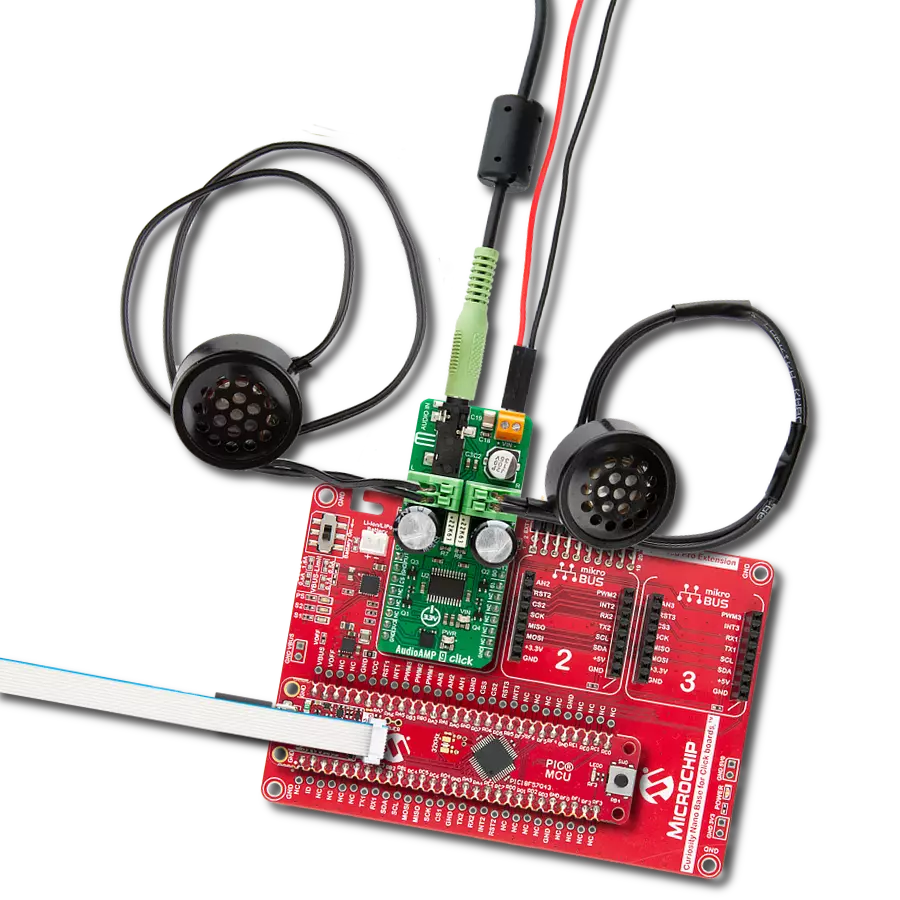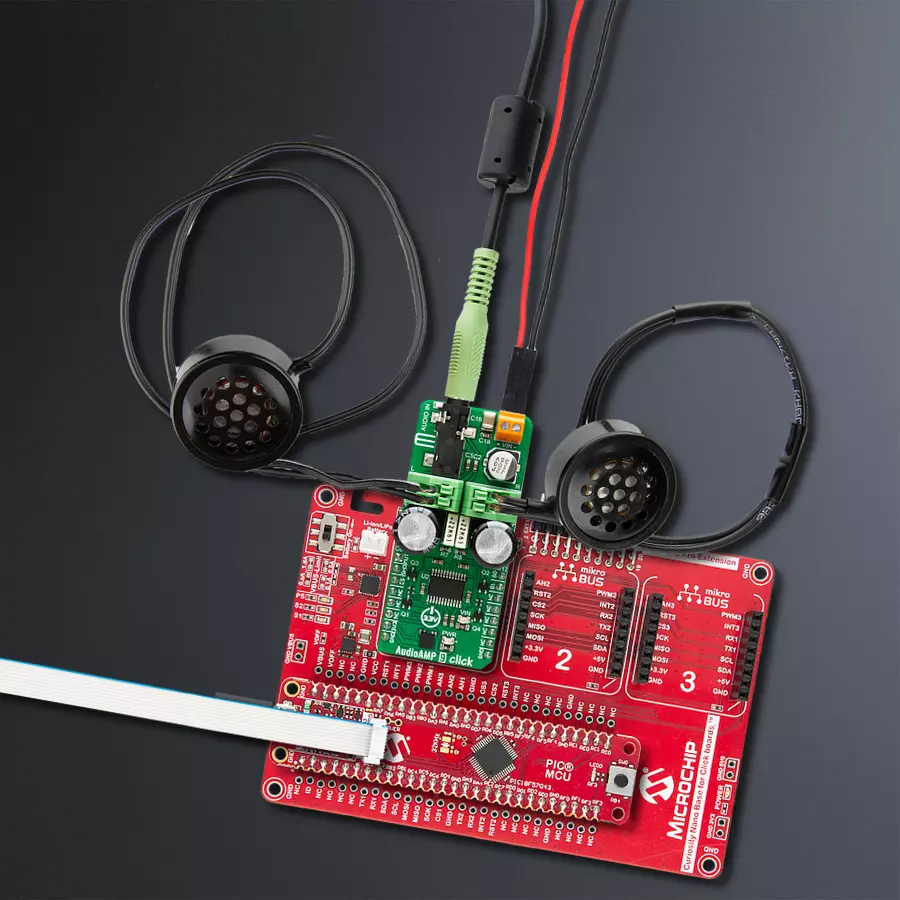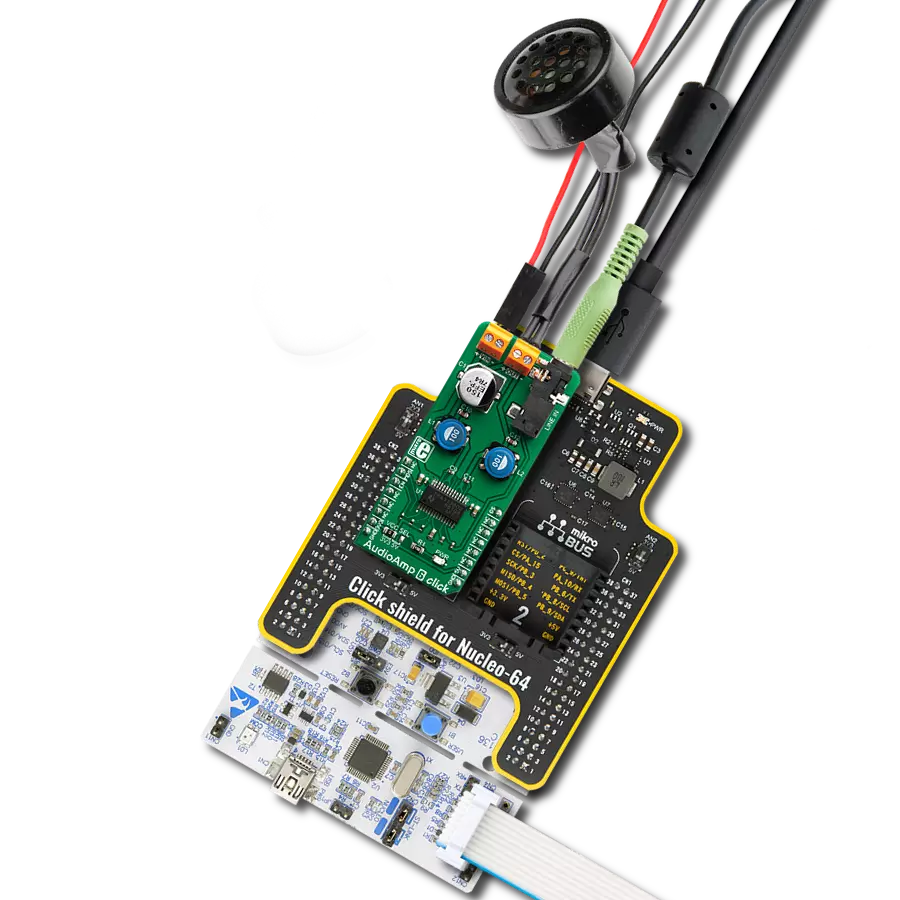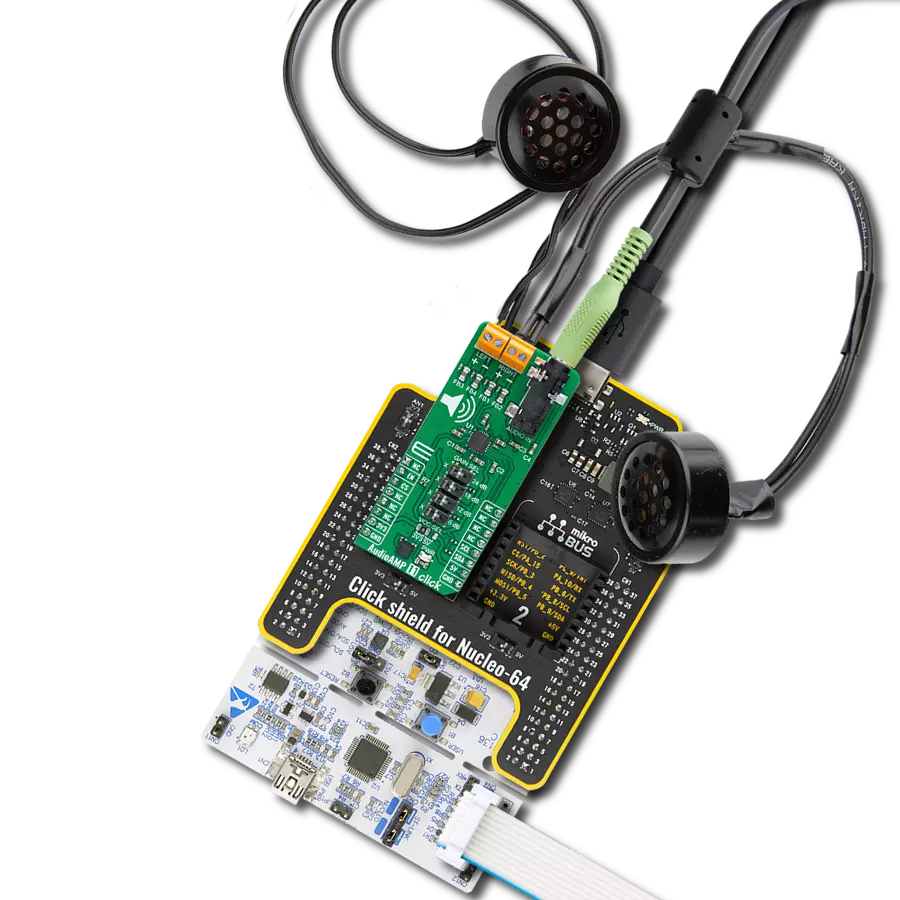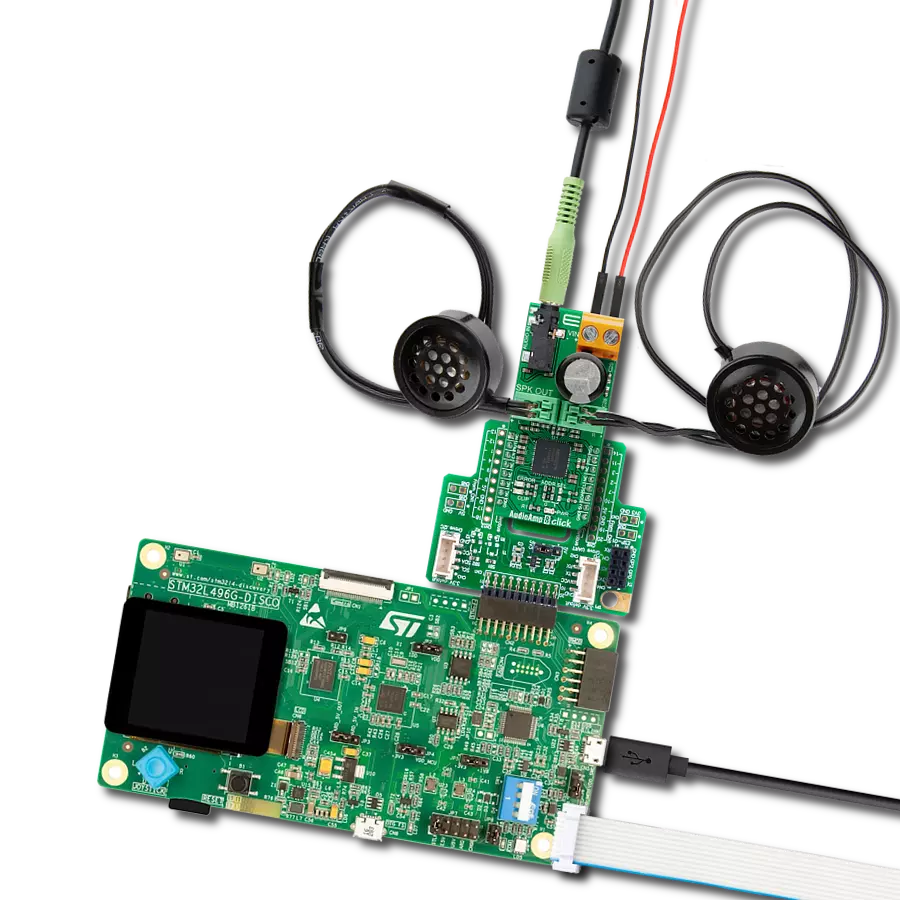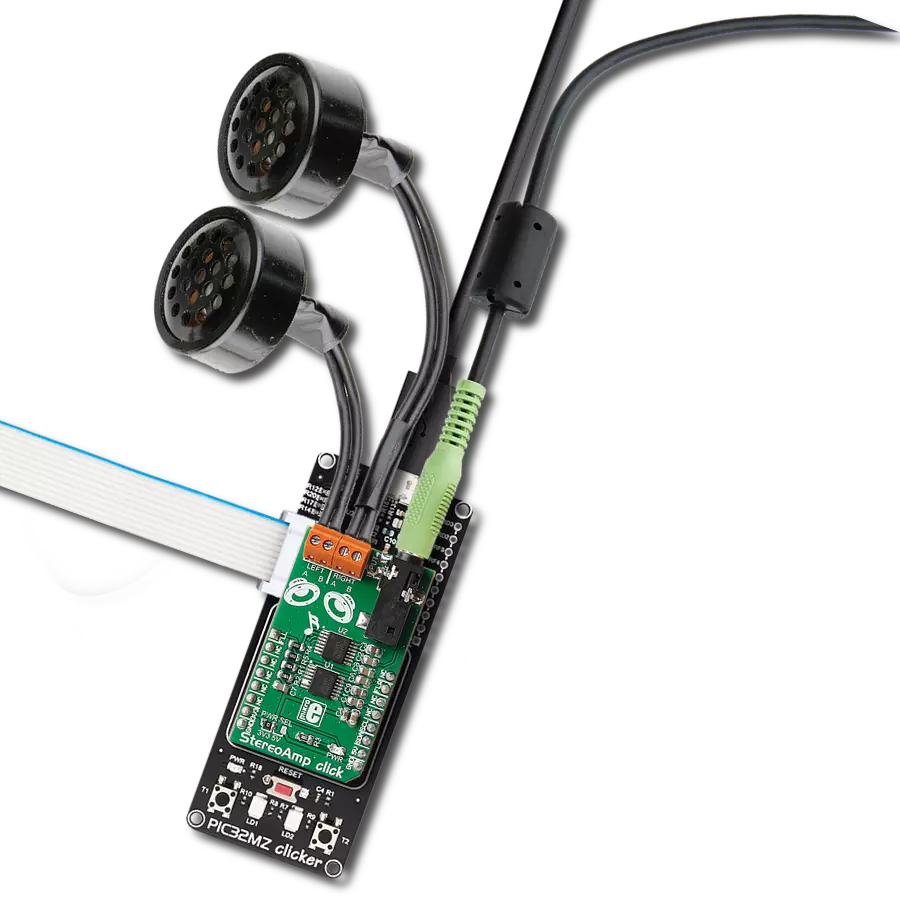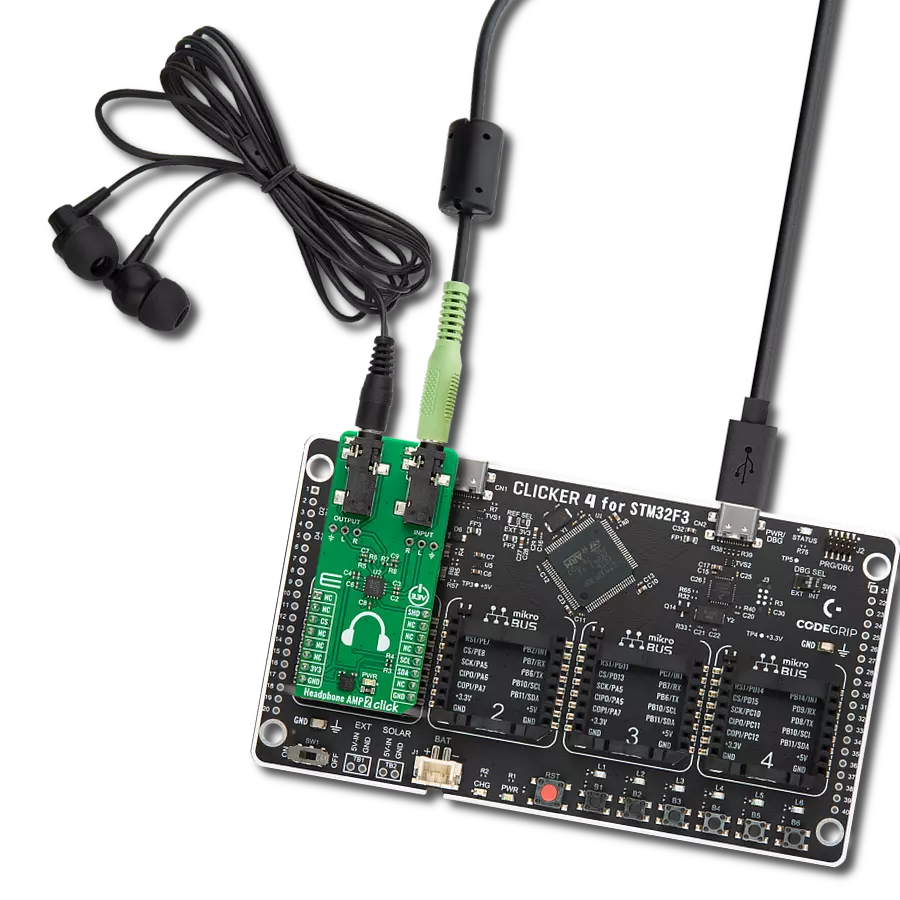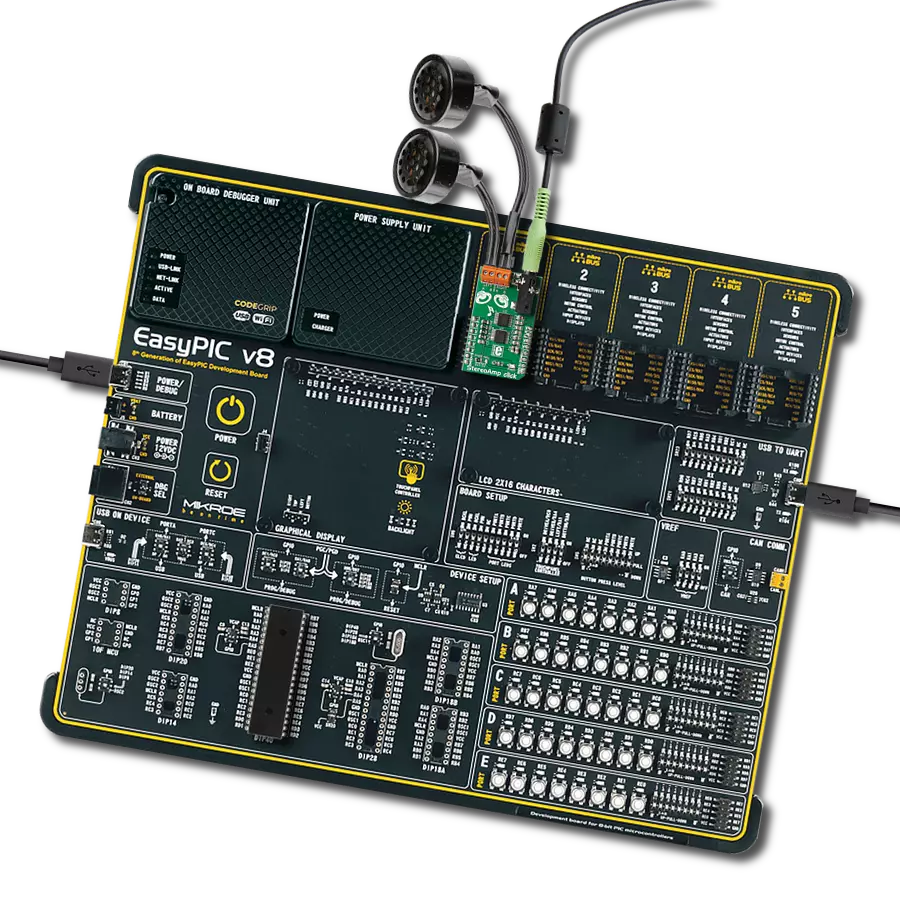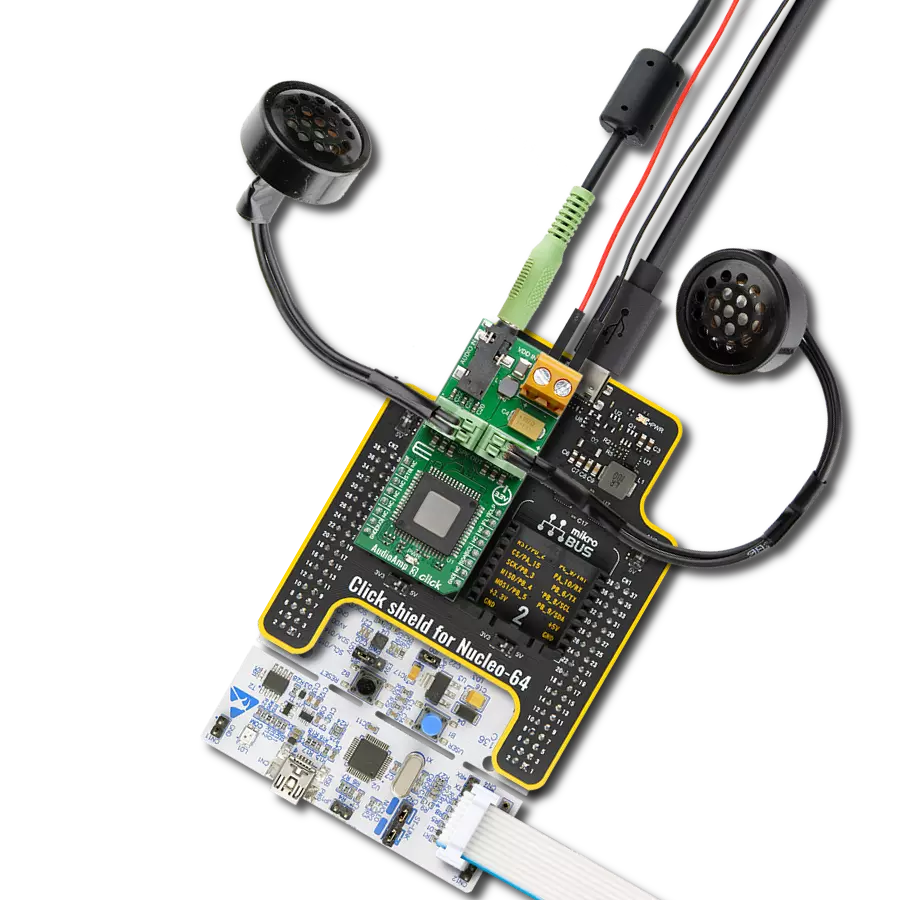Take your audio to new heights with a powerful and efficient audio-amplifying solution
A
A
Hardware Overview
How does it work?
AudioAMP 9 Click is based on the PAM8124, a stereo class-D audio power amplifier from Diodes Incorporated. Besides an excellent quantity performance, such as high efficiency, the PAM8124 is also characterized by high output power, low quiescent current, and eliminates the need for heat sinks. It can drive 8Ω stereo speakers in a single-ended configuration with 10W of output power per channel from the externally brought supply voltage. Furthermore, the PAM8124 has several protection features like thermal overload, short circuit, and over/under-voltage protection allowing a reliable operation. This GPIO configurable audio amplifier provides configurable features such as Mute, Shutdown, and selectable gain of the amplifier. The gain of the amplifier is controlled by two selectable gain pins, G1 and G2 pins of the mikroBUS™ socket,
offering 20dB, 26dB, 32dB, and 36dB gain selections. The MUT pin of the mikroBUS™ socket controls the output state of the PAM8124 (quick disable or enable of the outputs). A logic low state on this pin causes the outputs to run at a constant 50% duty cycle. A logic high state on this pin enables the outputs. The PAM8124 also employs a Shutdown operation mode to reduce supply current to the absolute minimum level during periods of non-use to save power. The SHD pin should be pulled low during normal operation when the amplifier is in use. Pulling the SHD pin high causes the outputs to mute and the amplifier to enter a low-current state. The amplifier should be set in Shutdown mode for the best power-off pop performance before removing the power supply voltage. For the best start-up pop performance, the amplifier should be put in Mute mode before restarting the amplifier.
This Click board™ supports an external power supply for the amplifier, which can be connected to the input terminal labeled as VIN and should be within the range of 12V to 24V, while the input audio can be brought to the input jack labeled as AUDIO IN and after specific processing reproduced on the speakers of the desired L/R channel. In addition, this board has an additional red LED indicator marked with VIN, which can visually detect the presence of an external power supply. This Click board™ can only be operated with a 3.3V logic voltage level. The board must perform appropriate logic voltage level conversion before using MCUs with different logic levels. However, the Click board™ comes equipped with a library containing functions and an example code that can be used as a reference for further development.
Features overview
Development board
PIC18F57Q43 Curiosity Nano evaluation kit is a cutting-edge hardware platform designed to evaluate microcontrollers within the PIC18-Q43 family. Central to its design is the inclusion of the powerful PIC18F57Q43 microcontroller (MCU), offering advanced functionalities and robust performance. Key features of this evaluation kit include a yellow user LED and a responsive
mechanical user switch, providing seamless interaction and testing. The provision for a 32.768kHz crystal footprint ensures precision timing capabilities. With an onboard debugger boasting a green power and status LED, programming and debugging become intuitive and efficient. Further enhancing its utility is the Virtual serial port (CDC) and a debug GPIO channel (DGI
GPIO), offering extensive connectivity options. Powered via USB, this kit boasts an adjustable target voltage feature facilitated by the MIC5353 LDO regulator, ensuring stable operation with an output voltage ranging from 1.8V to 5.1V, with a maximum output current of 500mA, subject to ambient temperature and voltage constraints.
Microcontroller Overview
MCU Card / MCU
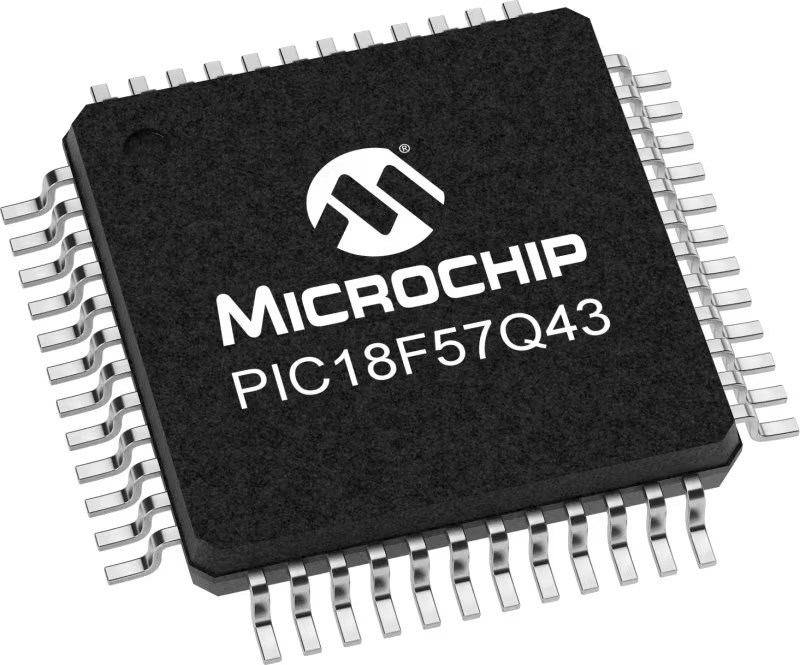
Architecture
PIC
MCU Memory (KB)
128
Silicon Vendor
Microchip
Pin count
48
RAM (Bytes)
8196
You complete me!
Accessories
Curiosity Nano Base for Click boards is a versatile hardware extension platform created to streamline the integration between Curiosity Nano kits and extension boards, tailored explicitly for the mikroBUS™-standardized Click boards and Xplained Pro extension boards. This innovative base board (shield) offers seamless connectivity and expansion possibilities, simplifying experimentation and development. Key features include USB power compatibility from the Curiosity Nano kit, alongside an alternative external power input option for enhanced flexibility. The onboard Li-Ion/LiPo charger and management circuit ensure smooth operation for battery-powered applications, simplifying usage and management. Moreover, the base incorporates a fixed 3.3V PSU dedicated to target and mikroBUS™ power rails, alongside a fixed 5.0V boost converter catering to 5V power rails of mikroBUS™ sockets, providing stable power delivery for various connected devices.
Used MCU Pins
mikroBUS™ mapper
Take a closer look
Click board™ Schematic

Step by step
Project assembly
Track your results in real time
Application Output
1. Application Output - In Debug mode, the 'Application Output' window enables real-time data monitoring, offering direct insight into execution results. Ensure proper data display by configuring the environment correctly using the provided tutorial.

2. UART Terminal - Use the UART Terminal to monitor data transmission via a USB to UART converter, allowing direct communication between the Click board™ and your development system. Configure the baud rate and other serial settings according to your project's requirements to ensure proper functionality. For step-by-step setup instructions, refer to the provided tutorial.

3. Plot Output - The Plot feature offers a powerful way to visualize real-time sensor data, enabling trend analysis, debugging, and comparison of multiple data points. To set it up correctly, follow the provided tutorial, which includes a step-by-step example of using the Plot feature to display Click board™ readings. To use the Plot feature in your code, use the function: plot(*insert_graph_name*, variable_name);. This is a general format, and it is up to the user to replace 'insert_graph_name' with the actual graph name and 'variable_name' with the parameter to be displayed.

Software Support
Library Description
This library contains API for AudioAMP 9 Click driver.
Key functions:
audioamp9_shutdown_onAudioAmp 9 shutdown on function.audioamp9_mute_offAudioAmp 9 mute off function.audioamp9_set_gain_levelAudioAmp 9 set gain function.
Open Source
Code example
The complete application code and a ready-to-use project are available through the NECTO Studio Package Manager for direct installation in the NECTO Studio. The application code can also be found on the MIKROE GitHub account.
/*!
* @file main.c
* @brief AudioAmp 9 Click Example.
*
* # Description
* This example demonstrates the use of the AudioAmp 9 Click board by
* changing the gain level.
*
* The demo application is composed of two sections :
*
* ## Application Init
* Initializes the driver and performs default configuration putting AudioAmp 9 Click
* into Gain 1 mode with unmuted output.
*
* ## Application Task
* Controlling the volume of the speaker by setting the gain level, and increasing it
* every 5 seconds until the maximum level is reached, then the sound is muted for 5 seconds.
*
* @author Stefan Ilic
*
*/
#include "board.h"
#include "log.h"
#include "audioamp9.h"
static audioamp9_t audioamp9; /**< AudioAmp 9 Click driver object. */
static log_t logger; /**< Logger object. */
void application_init ( void )
{
log_cfg_t log_cfg; /**< Logger config object. */
audioamp9_cfg_t audioamp9_cfg; /**< Click config object. */
/**
* Logger initialization.
* Default baud rate: 115200
* Default log level: LOG_LEVEL_DEBUG
* @note If USB_UART_RX and USB_UART_TX
* are defined as HAL_PIN_NC, you will
* need to define them manually for log to work.
* See @b LOG_MAP_USB_UART macro definition for detailed explanation.
*/
LOG_MAP_USB_UART( log_cfg );
log_init( &logger, &log_cfg );
log_info( &logger, " Application Init " );
// Click initialization.
audioamp9_cfg_setup( &audioamp9_cfg );
AUDIOAMP9_MAP_MIKROBUS( audioamp9_cfg, MIKROBUS_1 );
if ( DIGITAL_OUT_UNSUPPORTED_PIN == audioamp9_init( &audioamp9, &audioamp9_cfg ) )
{
log_error( &logger, " Communication init." );
for ( ; ; );
}
audioamp9_default_cfg ( &audioamp9 );
log_info( &logger, " Application Task " );
}
void application_task ( void )
{
for ( uint8_t vol_lvl = AUDIOAMP9_GAIN_LEVEL1; vol_lvl <= AUDIOAMP9_GAIN_LEVEL4; vol_lvl++ )
{
audioamp9_set_gain_level( &audioamp9, vol_lvl );
log_printf( &logger, " Volume gain level %d \r\n ", vol_lvl );
Delay_ms ( 1000 );
Delay_ms ( 1000 );
Delay_ms ( 1000 );
Delay_ms ( 1000 );
Delay_ms ( 1000 );
}
log_printf( &logger, " Sound is muted \r\n " );
audioamp9_mute_on( &audioamp9 );
Delay_ms ( 1000 );
Delay_ms ( 1000 );
Delay_ms ( 1000 );
Delay_ms ( 1000 );
Delay_ms ( 1000 );
log_printf( &logger, " Sound is unmuted \r\n " );
audioamp9_mute_off( &audioamp9 );
}
int main ( void )
{
/* Do not remove this line or clock might not be set correctly. */
#ifdef PREINIT_SUPPORTED
preinit();
#endif
application_init( );
for ( ; ; )
{
application_task( );
}
return 0;
}
// ------------------------------------------------------------------------ END
Additional Support
Resources
Category:Amplifier
